Node.js 核心模块
一、核心模块 path
- basename() 获取路径中基础名称
/**
* 01 返回的就是接收路径当中的最后一部分
* 02 第二个参数表示扩展名,如果说没有设置则返回完整的文件名称带后缀
* 03 第二个参数做为后缀时,如果没有在当前路径中被匹配到,那么就会忽略
* 04 处理目录路径的时候如果说,结尾处有路径分割符,则也会被忽略掉
*/
console.log(path.basename(__filename));
console.log(path.basename(__filename, '.js'));
console.log(path.basename(__filename, '.css'));
console.log(path.basename('/a/b/c'));
console.log(path.basename('/a/b/c/'));
/**
* 01 返回的就是接收路径当中的最后一部分
* 02 第二个参数表示扩展名,如果说没有设置则返回完整的文件名称带后缀
* 03 第二个参数做为后缀时,如果没有在当前路径中被匹配到,那么就会忽略
* 04 处理目录路径的时候如果说,结尾处有路径分割符,则也会被忽略掉
*/
console.log(path.basename(__filename));
console.log(path.basename(__filename, '.js'));
console.log(path.basename(__filename, '.css'));
console.log(path.basename('/a/b/c'));
console.log(path.basename('/a/b/c/'));
- dirname() 获取路径中目录名称
/**
* 01 返回路径中最后一个部分的上一层目录所在路径
*/
console.log(path.dirname(__filename));
console.log(path.dirname('/a/b/c'));
console.log(path.dirname('/a/b/c/'));
/**
* 01 返回路径中最后一个部分的上一层目录所在路径
*/
console.log(path.dirname(__filename));
console.log(path.dirname('/a/b/c'));
console.log(path.dirname('/a/b/c/'));
- extname()获取路径中扩展名称
/**
* 01 返回 path路径中相应文件的后缀名
* 02 如果 path 路径当中存在多个点,它匹配的是最后一个点,到结尾的内容
*/
console.log(path.extname(__filename));
console.log(path.extname('/a/b'));
console.log(path.extname('/a/b/index.html.js.css')); // .css
console.log(path.extname('/a/b/index.html.js.')); // .
/**
* 01 返回 path路径中相应文件的后缀名
* 02 如果 path 路径当中存在多个点,它匹配的是最后一个点,到结尾的内容
*/
console.log(path.extname(__filename));
console.log(path.extname('/a/b'));
console.log(path.extname('/a/b/index.html.js.css')); // .css
console.log(path.extname('/a/b/index.html.js.')); // .
- isAbsolute() 获取路径是否为绝对路径
console.log(path.isAbsolute('foo')); // false
console.log(path.isAbsolute('/foo')); // true
console.log(path.isAbsolute('///foo')); // true
console.log(path.isAbsolute('')); // false
console.log(path.isAbsolute('.')); // false
console.log(path.isAbsolute('../bar')); // false
console.log(path.isAbsolute('foo')); // false
console.log(path.isAbsolute('/foo')); // true
console.log(path.isAbsolute('///foo')); // true
console.log(path.isAbsolute('')); // false
console.log(path.isAbsolute('.')); // false
console.log(path.isAbsolute('../bar')); // false
- join() 拼接多个路径片段
console.log(path.join('a/b', 'c', 'index.html')); // a\b\c\index.html
console.log(path.join('/a/b', 'c', 'index.html')); // \a\b\c\index.html
console.log(path.join('/a/b', 'c', '../', 'index.html')); // \a\b\index.html
console.log(path.join('/a/b', 'c', './', 'index.html')); // \a\b\c\index.html
console.log(path.join('/a/b', 'c', '', 'index.html')); // \a\b\c\index.html
console.log(path.join(''));
console.log(path.join('a/b', 'c', 'index.html')); // a\b\c\index.html
console.log(path.join('/a/b', 'c', 'index.html')); // \a\b\c\index.html
console.log(path.join('/a/b', 'c', '../', 'index.html')); // \a\b\index.html
console.log(path.join('/a/b', 'c', './', 'index.html')); // \a\b\c\index.html
console.log(path.join('/a/b', 'c', '', 'index.html')); // \a\b\c\index.html
console.log(path.join(''));
- resolve() 返回绝对路径
/**
* resolve([from], to)
*/
console.log(path.resolve('/a', '../b')); // D:\b
console.log(path.resolve('index.html'));
/**
* resolve([from], to)
*/
console.log(path.resolve('/a', '../b')); // D:\b
console.log(path.resolve('index.html'));
- pasre() 解析路径
/**
* 01 接收一个路径,返回一个对象,包含不同的信息
* 02 root dir base ext name
*/
const obj = path.parse('/a/b/c/index.html');
// const obj = path.parse('/a/b/c/')
// const obj = path.parse('./a/b/c/')
console.log(obj);
/* {
root: '/',
dir: '/a/b/c',
base: 'index.html',
ext: '.html',
name: 'index'
} */
/**
* 01 接收一个路径,返回一个对象,包含不同的信息
* 02 root dir base ext name
*/
const obj = path.parse('/a/b/c/index.html');
// const obj = path.parse('/a/b/c/')
// const obj = path.parse('./a/b/c/')
console.log(obj);
/* {
root: '/',
dir: '/a/b/c',
base: 'index.html',
ext: '.html',
name: 'index'
} */
- format() 序列化路径
const obj = path.parse('./a/b/c/');
console.log(path.format(obj)); // ./a/b\c
const obj = path.parse('./a/b/c/');
console.log(path.format(obj)); // ./a/b\c
- normalize() 规范化路径
console.log(path.normalize(''));
console.log(path.normalize('a/b/c/d'));
console.log(path.normalize('a///b/c../d'));
console.log(path.normalize('a//\\/b/c\\/d'));
console.log(path.normalize('a//\b/c\\/d'));
console.log(path.normalize(''));
console.log(path.normalize('a/b/c/d'));
console.log(path.normalize('a///b/c../d'));
console.log(path.normalize('a//\\/b/c\\/d'));
console.log(path.normalize('a//\b/c\\/d'));
二、全局变量 Buffer
1. Buffer 全局变量
Buffer 可以让 Javascript 操作二进制(二进制数据、流操作、Buffer)。
起初 Javascript 语言服务于浏览器平台,Nodejs 平台下 JavaScript 可以实现 IO 操作(FS 等)。
IO 行为操作的就是二进制数据,Stream 流操作并非 Nodejs 独创,我们可以把它理解为一种数据类型(如数组、字符串)。
流操作配合管道实现数据分段传输,数据的端到端传输会生产者和消费者,生产和消费的过程往往存在等待。 产生等待时数据存在在哪?(Buffer)Nodejs 中 Buffer 是一片内存空间(C++),它不占据 V8 堆内存的大小,但由 JS 分配,由 v8 引擎的 GC 回收。
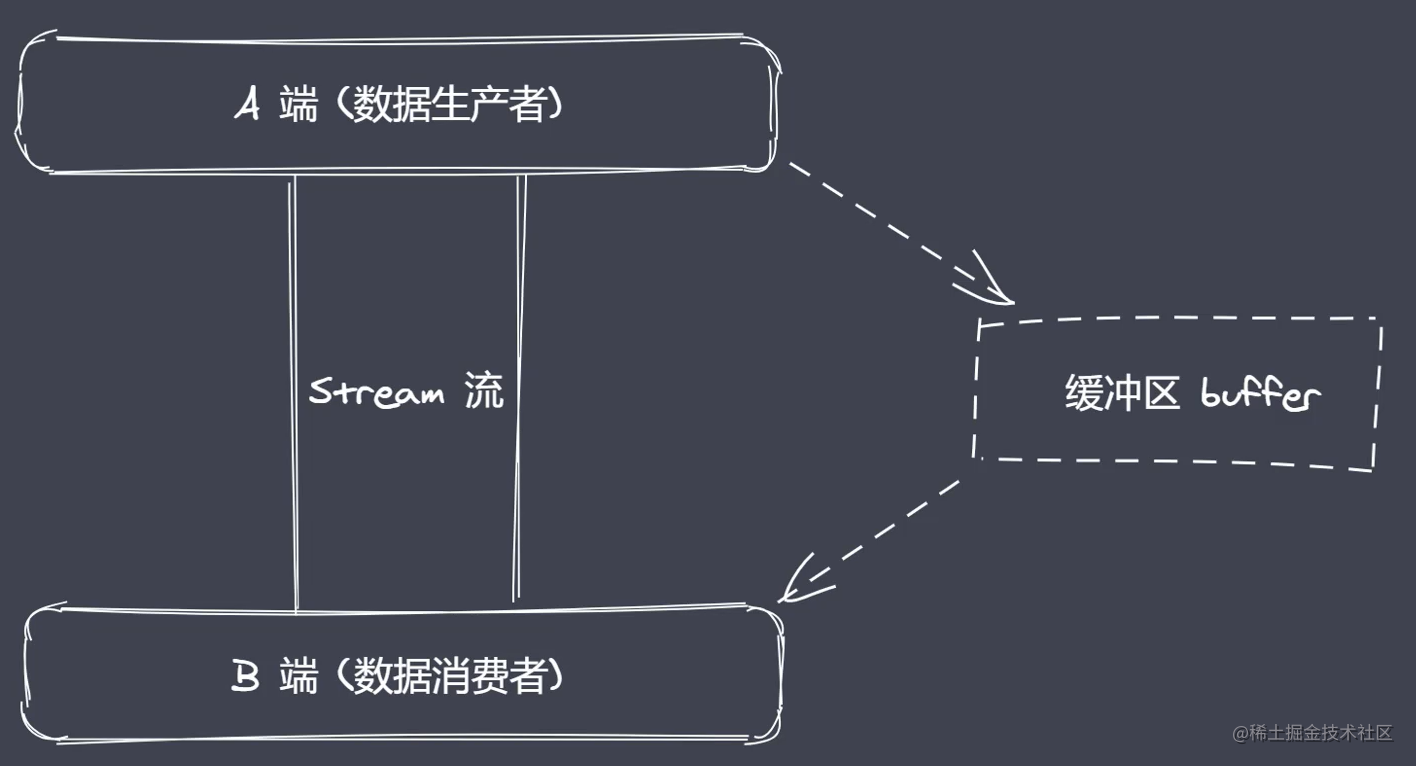
2. 创建 Buffer(类)
- alloc:创建指定字节大小的 buffer
const b1 = Buffer.alloc(10);
console.log(b1); // <Buffer 00 00 00 00 00 00 00 00 00 00>
const b1 = Buffer.alloc(10);
console.log(b1); // <Buffer 00 00 00 00 00 00 00 00 00 00>
- allocUnsafe:创建指定大小的 buffer(不安全),只要有内存空间就会使用
const b2 = Buffer.allocUnsafe(10);
console.log(b2); // <Buffer d0 d8 49 b8 3e 02 00 00 28 d9>
const b2 = Buffer.allocUnsafe(10);
console.log(b2); // <Buffer d0 d8 49 b8 3e 02 00 00 28 d9>
- from:接收数据,创建 buffer(编码可选--'utf-8'),接收字符串或数组参数作为数据。
const b1 = Buffer.from('中', 'utf-8');
console.log(b1); // <Buffer e4 b8 ad>
const b2 = Buffer.from([0xe4, 0xb8, 0xad]);
console.log(b2); // <Buffer e4 b8 ad>
console.log(b2.toString('utf-8')); // 中
const b3 = Buffer.alloc(3);
const b4 = Buffer.from(b3);
console.log(b3); // <Buffer 00 00 00>
console.log(b4); // <Buffer 00 00 00>
// 两者的内存空间不共享的
b3[0] = 1;
console.log(b3); // <Buffer 01 00 00>
console.log(b4); // <Buffer 00 00 00>
const b1 = Buffer.from('中', 'utf-8');
console.log(b1); // <Buffer e4 b8 ad>
const b2 = Buffer.from([0xe4, 0xb8, 0xad]);
console.log(b2); // <Buffer e4 b8 ad>
console.log(b2.toString('utf-8')); // 中
const b3 = Buffer.alloc(3);
const b4 = Buffer.from(b3);
console.log(b3); // <Buffer 00 00 00>
console.log(b4); // <Buffer 00 00 00>
// 两者的内存空间不共享的
b3[0] = 1;
console.log(b3); // <Buffer 01 00 00>
console.log(b4); // <Buffer 00 00 00>
3. Buffer 实例方法
- fill:使用数据填充 buffer
// buf.fill(123) // <Buffer 7b 7b 7b 7b 7b 7b>
buf.fill('12345678', 1, 3); // 填充数据 开始 结束 (完全填充)
console.log(buf); // <Buffer 00 31 32 00 00 00>
console.log(buf.toString()); // 12
// buf.fill(123) // <Buffer 7b 7b 7b 7b 7b 7b>
buf.fill('12345678', 1, 3); // 填充数据 开始 结束 (完全填充)
console.log(buf); // <Buffer 00 31 32 00 00 00>
console.log(buf.toString()); // 12
- write:向 buffer 中写入数据
buf.write('123', 1, 4); // 填充数据 开始 长度(一般填充)
console.log(buf); // <Buffer 00 31 32 33 00 00>
console.log(buf.toString()); // 123
buf.write('123', 1, 4); // 填充数据 开始 长度(一般填充)
console.log(buf); // <Buffer 00 31 32 33 00 00>
console.log(buf.toString()); // 123
- toString: 从 buffer 中提取数据
buf = Buffer.from('拉勾教育');
console.log(buf); // <Buffer e6 8b 89 e5 8b be e6 95 99 e8 82 b2>
console.log(buf.toString('utf-8', 3, 9)); // 字符编码 开始 结束 (勾教)
buf = Buffer.from('拉勾教育');
console.log(buf); // <Buffer e6 8b 89 e5 8b be e6 95 99 e8 82 b2>
console.log(buf.toString('utf-8', 3, 9)); // 字符编码 开始 结束 (勾教)
- slice: 截取 buffer
buf = Buffer.from('拉勾教育');
let b1 = buf.slice(-3);
console.log(b1); // <Buffer e8 82 b2>
console.log(b1.toString()); // 育
buf = Buffer.from('拉勾教育');
let b1 = buf.slice(-3);
console.log(b1); // <Buffer e8 82 b2>
console.log(b1.toString()); // 育
- indexOf: 在 buffer 中查找数据
buf = Buffer.from('zcesaddwewqrqggnddd');
console.log(buf);
console.log(buf.indexOf('qc', 4)); // -1
buf = Buffer.from('zcesaddwewqrqggnddd');
console.log(buf);
console.log(buf.indexOf('qc', 4)); // -1
- copy:拷贝 buffer 中的数据
let b1 = Buffer.alloc(6);
let b2 = Buffer.from('拉勾');
b2.copy(b1, 3, 3, 6); // 将b2拷贝到b1中 开始写入位置 开始读取位置 长度
console.log(b1.toString());
console.log(b2.toString());
let b1 = Buffer.alloc(6);
let b2 = Buffer.from('拉勾');
b2.copy(b1, 3, 3, 6); // 将b2拷贝到b1中 开始写入位置 开始读取位置 长度
console.log(b1.toString());
console.log(b2.toString());
4. Buffer 静态方法
- concat:将多个 buffer 拼接成一个新的 buffer
let b1 = Buffer.from('hello');
let b2 = Buffer.from('world');
let b = Buffer.concat([b1, b2], 9);
console.log(b);
console.log(b.toString()); // helloworl
let b1 = Buffer.from('hello');
let b2 = Buffer.from('world');
let b = Buffer.concat([b1, b2], 9);
console.log(b);
console.log(b.toString()); // helloworl
- isBuffer:判断当前数据是否为 buffer
let b1 = '123';
console.log(Buffer.isBuffer(b1)); // false
let b1 = '123';
console.log(Buffer.isBuffer(b1)); // false
5. Buffer-split 实现
ArrayBuffer.prototype.split = function (sep) {
let len = Buffer.from(sep).length;
let ret = [];
let start = 0;
let offset = 0;
while ((offset = this.indexOf(sep, start) !== -1)) {
ret.push(this.slice(start, offset));
start = offset + len;
}
ret.push(this.slice(start));
return ret;
};
let buf = '哈皮,凉皮,好顽皮';
let bufArr = buf.split('皮');
console.log(bufArr); // [ '哈', ',凉', ',好顽', '' ]
ArrayBuffer.prototype.split = function (sep) {
let len = Buffer.from(sep).length;
let ret = [];
let start = 0;
let offset = 0;
while ((offset = this.indexOf(sep, start) !== -1)) {
ret.push(this.slice(start, offset));
start = offset + len;
}
ret.push(this.slice(start));
return ret;
};
let buf = '哈皮,凉皮,好顽皮';
let bufArr = buf.split('皮');
console.log(bufArr); // [ '哈', ',凉', ',好顽', '' ]
三、核心模块 FS

1. 前置知识
用户对于文件所具备的操作权限:R(读-8)W(写-4)S(执行-1)(不具备权限-0)。 操作系统将用户分为 3 类:文件所有者(自己)、文件所属组(家人)、访客(陌生人)。


2. Nodejs 中 flag 表示对文件操作方式,常见 flag 操作符
- r:表示可读
- w:表示可写
- s:表示同步
- +:表示执行相反操作
- x:表示排它操作
- a:表示追加操作
3. fs 介绍
- fd 就是操作系统分配给被打开文件的标识(描述符从 3 开始的)
- 代码层面上 fs 分为基本操作类和常用 API
- 文件操作概念:权限位、标识符、操作符
4. 文件操作 API
- readFile:从指定文件中读取数据
fs.readFile(path.resolve('data1.txt'), 'utf-8', (err, data) => {
// 在Nodejs中错误优先
console.log(err);
if (!null) {
console.log(data);
}
});
fs.readFile(path.resolve('data1.txt'), 'utf-8', (err, data) => {
// 在Nodejs中错误优先
console.log(err);
if (!null) {
console.log(data);
}
});
- writeFile:向指定文件中写入数据
fs.writeFile(
'data.txt',
'123',
{
mode: 438,
flag: 'w+',
encoding: 'utf-8',
},
(err) => {
if (!err) {
fs.readFile('data.txt', 'utf-8', (err, data) => {
console.log(data);
});
}
}
);
fs.writeFile(
'data.txt',
'123',
{
mode: 438,
flag: 'w+',
encoding: 'utf-8',
},
(err) => {
if (!err) {
fs.readFile('data.txt', 'utf-8', (err, data) => {
console.log(data);
});
}
}
);
- appendFile: 追加的方式向指定文件中写入数据
fs.appendFile('data.txt', 'hello node.js', {}, (err) => {
console.log('写入成功');
});
fs.appendFile('data.txt', 'hello node.js', {}, (err) => {
console.log('写入成功');
});
- copyFile:将某个文件中的数据拷贝至另一文件
fs.copyFile('data.txt', 'test.txt', () => {
console.log('拷贝成功');
});
fs.copyFile('data.txt', 'test.txt', () => {
console.log('拷贝成功');
});
- watchFile:对指定文件进行监控
fs.watchFile('data.txt', { interval: 20 }, (curr, prev) => {
if (curr.mtime !== prev.mtime) {
console.log('文件被修改了');
fs.unwatchFile('data.txt');
}
});
fs.watchFile('data.txt', { interval: 20 }, (curr, prev) => {
if (curr.mtime !== prev.mtime) {
console.log('文件被修改了');
fs.unwatchFile('data.txt');
}
});
5. md 转 html 实现-核心代码
// 核心代码
fs.watchFile(mdPath, (curr, prev) => {
if (curr.mtime !== prev.mtime) {
fs.readFile(mdPath, 'utf-8', (err, data) => {
// 将 md--》html
let htmlStr = marked(data);
fs.readFile(cssPath, 'utf-8', (err, data) => {
let retHtml = temp
.replace('{{content}}', htmlStr)
.replace('{{style}}', data);
// 将上述的内容写入到指定的 html 文件中,用于在浏览器里进行展示
fs.writeFile(htmlPath, retHtml, (err) => {
console.log('html 生成成功了');
});
});
});
}
});
// 核心代码
fs.watchFile(mdPath, (curr, prev) => {
if (curr.mtime !== prev.mtime) {
fs.readFile(mdPath, 'utf-8', (err, data) => {
// 将 md--》html
let htmlStr = marked(data);
fs.readFile(cssPath, 'utf-8', (err, data) => {
let retHtml = temp
.replace('{{content}}', htmlStr)
.replace('{{style}}', data);
// 将上述的内容写入到指定的 html 文件中,用于在浏览器里进行展示
fs.writeFile(htmlPath, retHtml, (err) => {
console.log('html 生成成功了');
});
});
});
}
});
6. 文件打开与关闭 (作用:适应大文件的操作, readFile 等是一次性内存操作)
// open
fs.open(path.resolve('data.txt'), 'r', (err, fd) => {
console.log(fd); // 3 (打开了)
});
// close
fs.open('data.txt', 'r', (err, fd) => {
console.log(fd);
fs.close(fd, (err) => {
console.log('关闭成功');
});
});
// open
fs.open(path.resolve('data.txt'), 'r', (err, fd) => {
console.log(fd); // 3 (打开了)
});
// close
fs.open('data.txt', 'r', (err, fd) => {
console.log(fd);
fs.close(fd, (err) => {
console.log('关闭成功');
});
});
7. 大文件读写操作(一次性读写无须 Buffer, 大文件边读边写需 Buffer)

const fs = require('fs');
// read : 所谓的读操作就是将数据从磁盘文件中写入到 buffer 中
let buf = Buffer.alloc(10);
fs.open('data.txt', 'r', (err, rfd) => {
console.log(rfd);
/**
* fs.read(fd, buffer, offset, length, position, callback)
* fd 定位当前被打开的文件
* buffer 用于表示当前缓冲区
* offset 表示当前从 buffer 的哪个位置开始执行写入
* length 表示当前次写入的长度
* position 表示当前从文件的哪个位置开始读取
* callback 回调函数接受三个参数,即(错误,字节读取,缓冲区)
*/
fs.read(rfd, buf, 0, 4, 0, (err, readBytes, data) => {
console.log(readBytes);
console.log(data);
console.log(data.toString());
});
});
// write 将缓冲区里的内容写入到磁盘文件中
buf = Buffer.from('1234567890');
fs.open('b.txt', 'w', (err, wfd) => {
/**
* fs.write(fd, buffer, offset, length, position, callback)
*/
fs.write(wfd, buf, 0, 4, 0, (err, written, buffer) => {
console.log(written, '----');
fs.close(wfd);
});
});
const fs = require('fs');
// read : 所谓的读操作就是将数据从磁盘文件中写入到 buffer 中
let buf = Buffer.alloc(10);
fs.open('data.txt', 'r', (err, rfd) => {
console.log(rfd);
/**
* fs.read(fd, buffer, offset, length, position, callback)
* fd 定位当前被打开的文件
* buffer 用于表示当前缓冲区
* offset 表示当前从 buffer 的哪个位置开始执行写入
* length 表示当前次写入的长度
* position 表示当前从文件的哪个位置开始读取
* callback 回调函数接受三个参数,即(错误,字节读取,缓冲区)
*/
fs.read(rfd, buf, 0, 4, 0, (err, readBytes, data) => {
console.log(readBytes);
console.log(data);
console.log(data.toString());
});
});
// write 将缓冲区里的内容写入到磁盘文件中
buf = Buffer.from('1234567890');
fs.open('b.txt', 'w', (err, wfd) => {
/**
* fs.write(fd, buffer, offset, length, position, callback)
*/
fs.write(wfd, buf, 0, 4, 0, (err, written, buffer) => {
console.log(written, '----');
fs.close(wfd);
});
});
8. 文件拷贝自定义实现(处理大文件)
/**
* 01 打开 a 文件,利用 read 将数据保存到 buffer 暂存起来
* 02 打开 b 文件,利用 write 将 buffer 中数据写入到 b 文件中
*/
const BUFFER_SIZE = buf.length;
let readOffset = 0;
fs.open('a.txt', 'r', (err, rfd) => {
fs.open('b.txt', 'w', (err, wfd) => {
function next() {
fs.read(rfd, buf, 0, BUFFER_SIZE, readOffset, (err, readBytes) => {
if (!readBytes) {
// 如果条件成立,说明内容已经读取完毕
fs.close(rfd, () => {});
fs.close(wfd, () => {});
console.log('拷贝完成');
return;
}
readOffset += readBytes;
fs.write(wfd, buf, 0, readBytes, (err, written) => {
next();
});
});
}
next();
});
});
/**
* 01 打开 a 文件,利用 read 将数据保存到 buffer 暂存起来
* 02 打开 b 文件,利用 write 将 buffer 中数据写入到 b 文件中
*/
const BUFFER_SIZE = buf.length;
let readOffset = 0;
fs.open('a.txt', 'r', (err, rfd) => {
fs.open('b.txt', 'w', (err, wfd) => {
function next() {
fs.read(rfd, buf, 0, BUFFER_SIZE, readOffset, (err, readBytes) => {
if (!readBytes) {
// 如果条件成立,说明内容已经读取完毕
fs.close(rfd, () => {});
fs.close(wfd, () => {});
console.log('拷贝完成');
return;
}
readOffset += readBytes;
fs.write(wfd, buf, 0, readBytes, (err, written) => {
next();
});
});
}
next();
});
});
四、FS 目录操作
1. 目录操作 API
- access:判断文件或目录是否具有操作权限
fs.access('a.txt', (err) => {
if (err) {
console.log(err);
} else {
console.log('有操作权限');
}
});
fs.access('a.txt', (err) => {
if (err) {
console.log(err);
} else {
console.log('有操作权限');
}
});
- stat:获取目录及文件信息
// fs.stat( path, options, callback )
fs.stat('a.txt', (err, statObj) => {
// stats: 它是包含文件路径细节的Stats对象
console.log(statObj.size);
console.log(statObj.isFile());
console.log(statObj.isDirectory());
});
// fs.stat( path, options, callback )
fs.stat('a.txt', (err, statObj) => {
// stats: 它是包含文件路径细节的Stats对象
console.log(statObj.size);
console.log(statObj.isFile());
console.log(statObj.isDirectory());
});
- mkdir:创建目录
// fs.mkdir(path, mode, callback)
// 设置 recursive: true 为了处理目录已经存在的情况(递归)
fs.mkdir('a/b/c', { recursive: true }, (err) => {
if (!err) {
console.log('创建成功');
} else {
console.log(err);
}
});
// fs.mkdir(path, mode, callback)
// 设置 recursive: true 为了处理目录已经存在的情况(递归)
fs.mkdir('a/b/c', { recursive: true }, (err) => {
if (!err) {
console.log('创建成功');
} else {
console.log(err);
}
});
- rmdir:删除目录
fs.rmdir('a', { recursive: true }, (err) => {
if (!err) {
console.log('删除成功');
} else {
console.log(err);
}
});
fs.rmdir('a', { recursive: true }, (err) => {
if (!err) {
console.log('删除成功');
} else {
console.log(err);
}
});
- readdir:读取目录中内容
fs.readdir('a/b', (err, files) => {
console.log(files);
});
fs.readdir('a/b', (err, files) => {
console.log(files);
});
- unlink:删除指定文件
fs.unlink('a/a.txt', (err) => {
if (!err) {
console.log('删除成功');
}
});
fs.unlink('a/a.txt', (err) => {
if (!err) {
console.log('删除成功');
}
});
- 目录创建-同步实现
const fs = require('fs')
const path = require('path')
/**
* 01 将来调用时需要接收类似于 a/b/c ,这样的路径,它们之间是采用 / 去行连接
* 02 利用 / 分割符将路径进行拆分,将每一项放入一个数组中进行管理 ['a', 'b', 'c']
* 03 对上述的数组进行遍历,我们需要拿到每一项,然后与前一项进行拼接 /
* 04 判断一个当前对拼接之后的路径是否具有可操作的权限,如果有则证明存在,否则的话就需要执行创建
*/
function makeDirSync (dirPath) {
let items = dirPath.split(path.sep)
for(let i = 1; i <= items.length; i++) {
let dir = items.slice(0, i).join(path.sep)
try {
fs.accessSync(dir)
} catch (err) {
fs.mkdirSync(dir)
}
}
}
makeDirSync('a\\b\\c')
const fs = require('fs')
const path = require('path')
/**
* 01 将来调用时需要接收类似于 a/b/c ,这样的路径,它们之间是采用 / 去行连接
* 02 利用 / 分割符将路径进行拆分,将每一项放入一个数组中进行管理 ['a', 'b', 'c']
* 03 对上述的数组进行遍历,我们需要拿到每一项,然后与前一项进行拼接 /
* 04 判断一个当前对拼接之后的路径是否具有可操作的权限,如果有则证明存在,否则的话就需要执行创建
*/
function makeDirSync (dirPath) {
let items = dirPath.split(path.sep)
for(let i = 1; i <= items.length; i++) {
let dir = items.slice(0, i).join(path.sep)
try {
fs.accessSync(dir)
} catch (err) {
fs.mkdirSync(dir)
}
}
}
makeDirSync('a\\b\\c')
- 目录创建-异步实现
const fs = require('fs')
const path = require('path')
const {promisify} = require('util')
// 将 access 与 mkdir 处理成 async... 风格
const access = promisify(fs.access)
const mkdir = promisify(fs.mkdir)
async function myMkdir (dirPath, cb) {
let parts = dirPath.split('/')
for(let index = 1; index <= parts.length; index++) {
let current = parts.slice(0, index).join('/')
try {
await access(current)
} catch (err) {
await mkdir(current)
}
}
cb && cb()
}
myMkdir('a/b/c', () => {
console.log('创建成功')
})
const fs = require('fs')
const path = require('path')
const {promisify} = require('util')
// 将 access 与 mkdir 处理成 async... 风格
const access = promisify(fs.access)
const mkdir = promisify(fs.mkdir)
async function myMkdir (dirPath, cb) {
let parts = dirPath.split('/')
for(let index = 1; index <= parts.length; index++) {
let current = parts.slice(0, index).join('/')
try {
await access(current)
} catch (err) {
await mkdir(current)
}
}
cb && cb()
}
myMkdir('a/b/c', () => {
console.log('创建成功')
})
- 目录删除-同步实现
const { dir } = require('console')
const fs = require('fs')
const path = require('path')
/**
* 需求:自定义一个函数,接收一个路径,然后执行删除
* 01 判断当前传入的路径是否为一个文件,直接删除当前文件即可
* 02 如果当前传入的是一个目录,我们需要继续读取目录中的内容,然后再执行删除操作
* 03 将删除行为定义成一个函数,然后通过递归的方式进行复用
* 04 将当前的名称拼接成在删除时可使用的路径
*/
function myRmdir (dirPath, cb) {
// 判断当前 dirPath 的类型
fs.stat(dirPath, (err, statObj) => {
if (statObj.isDirectory()) {
// 目录---> 继续读取
fs.readdir(dirPath, (err, files) => {
let dirs = files.map(item => {
return path.join(dirPath, item)
})
let index = 0
function next () {
if (index == dirs.length) return fs.rmdir(dirPath, cb)
let current = dirs[index++]
myRmdir(current, next)
}
next()
})
} else {
// 文件---> 直接删除
fs.unlink(dirPath, cb)
}
})
}
myRmdir('tmp', () => {
console.log('删除成功了')
})
const { dir } = require('console')
const fs = require('fs')
const path = require('path')
/**
* 需求:自定义一个函数,接收一个路径,然后执行删除
* 01 判断当前传入的路径是否为一个文件,直接删除当前文件即可
* 02 如果当前传入的是一个目录,我们需要继续读取目录中的内容,然后再执行删除操作
* 03 将删除行为定义成一个函数,然后通过递归的方式进行复用
* 04 将当前的名称拼接成在删除时可使用的路径
*/
function myRmdir (dirPath, cb) {
// 判断当前 dirPath 的类型
fs.stat(dirPath, (err, statObj) => {
if (statObj.isDirectory()) {
// 目录---> 继续读取
fs.readdir(dirPath, (err, files) => {
let dirs = files.map(item => {
return path.join(dirPath, item)
})
let index = 0
function next () {
if (index == dirs.length) return fs.rmdir(dirPath, cb)
let current = dirs[index++]
myRmdir(current, next)
}
next()
})
} else {
// 文件---> 直接删除
fs.unlink(dirPath, cb)
}
})
}
myRmdir('tmp', () => {
console.log('删除成功了')
})
五、Nodejs 模块化
1. 模块化历程
传统开发常见问题:命名冲突和污染、代码冗余,无效请求多、文件间的依赖关系复杂,导致项目难以维护,不可复用。模块是小而精且可利用维护的代码块,可以利用函数、对象、执行函数拆分。
Commonjs 规范类似 ECMAscript 规范。Commonjs 规范是同步加载模块,不适用浏览器加载。
AMD 规范(require.js)、CMD 规范(sea.js)、ES modules 规范(ES6)。
2. Commonjs 规范
Commonjs 是语言层面的规范:模块引用、模块定义、模块标识。
Nodejs 语言的实现:任一文件都是模块,具有独立作用域;使用 require 导入其他模块;将模块 ID 传入 require 实现目标模块的定位。
- CommonJS 规范起初是为了弥补 JS 语言模块化缺陷
- CommonJS 是语言层面的规范,当前主要用于 Node.js
- CommonJS 规定模块化分为引入、定义、标识符三个部分
- Moudle 在任意模块中可直接使用包含模块信息
- Require 接收标识符,加载目标模块
- Exports 与 module.exports 都能导出模块数据
- CommonJS 规范定义模块的加载是同步完成
3. module 属性
- 任意 js 文件就是一个模块,可以直接使用 module 属性
- id:返回模块标识符,一般是一个绝对路径
- filename:返回文件模块的绝对路径
- loaded:返回布尔值,表示模块是否完成加载
- parent: 返回对象存放调用当前模块的模块
- children: 返回数组,存放当前模块调用的其它模块
- exports: 返回当前模块需要暴露的内容
- paths:返回数组,存放不同目录下的 node_modules 位置
4. module.export 与 exports 的区别?
exports 是 Nodejs 为了便于使用,定义的一个指向 module.export 内存地址的变量,不能被赋值为其他数值,否则就切断了和 module.export 的联系 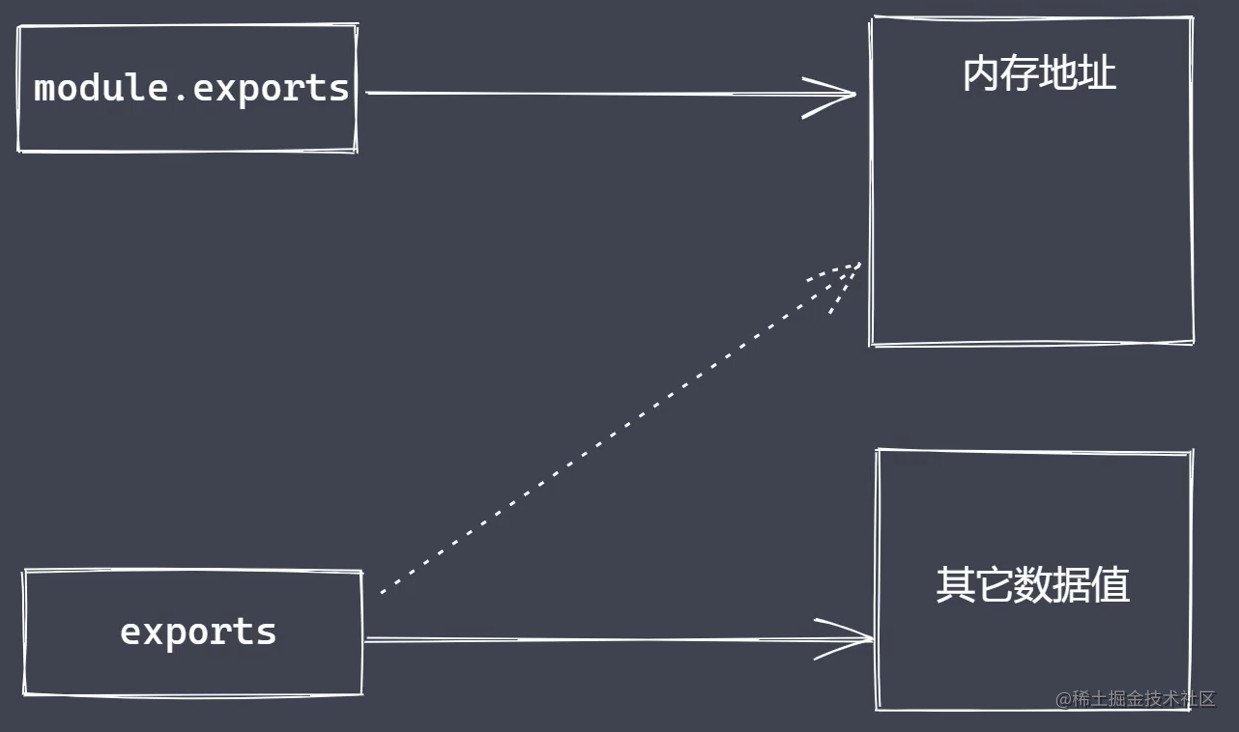
5. require 属性
- 基本功能是读入并且执行一个模块文件
- resolve: 返回模块文件绝对路径
- extensions: 依据不同后缀名执行解析操作
- main:返回主模块对象
6. Nodejs 模块分类
- 内置模块:加载速度(Node 源码编译时写入到二进制文件)、
- 文件模块:加载速度(代码运行时,动态加载)
7. 模块加载流程
- 路径分析:依据标识符确定模块位置。路径标识符,非路径标识符(常见于核心模块 如 fs),模块路径(路径依次向上查找 node_modules,直到盘符根)
- 文件定位:确定目标模块中具体的文件及文件类型。
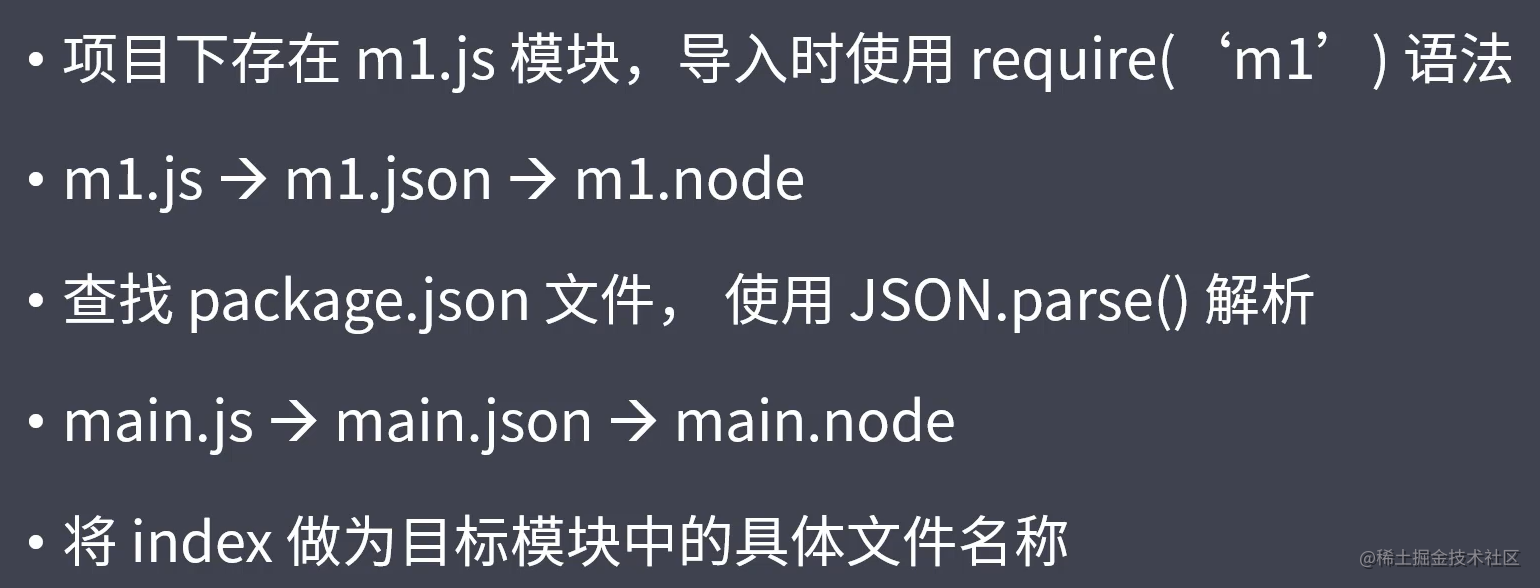
- 编译执行:采用对应的方式完成文件的编译执行。
- 使用 fs 模块同步读入目标文件内容
- 对内容进行语法包装,生成可执行 JS 函数
- 调用函数时传入 exports、module、require 等属性值
- 以上 3 点是对 JS 文件的编译,对 JSON 文件编译是将读取到的内容通过 JSON.parse()进行解析。
- 缓存优先原则
- 提高模块加载速度
- 当前模块不存在,则经历一次完整加载流程
- 模块加载完成后,使用路径作为索引进行缓存
六、模块加载分析
1. 源码分析及内置模块 VM(创建独立运行的沙箱环境)
const fs = require('fs');
const vm = require('vm');
let age = 33;
let content = fs.readFileSync('test.txt', 'utf-8');
// eval
// eval(content)
// new Function
/* console.log(age)
let fn = new Function('age', "return age + 1")
console.log(fn(age)) */
// vm.runInThisContext(content)
// 默认无法使用外部局部变量,但可以使用全局变量
vm.runInThisContext('age += 10');
console.log(age);
const fs = require('fs');
const vm = require('vm');
let age = 33;
let content = fs.readFileSync('test.txt', 'utf-8');
// eval
// eval(content)
// new Function
/* console.log(age)
let fn = new Function('age', "return age + 1")
console.log(fn(age)) */
// vm.runInThisContext(content)
// 默认无法使用外部局部变量,但可以使用全局变量
vm.runInThisContext('age += 10');
console.log(age);
2. 模块加载流程实现(以文件加载为例)
- 路径分析
- 缓存优化
- 文件定位
- 编译执行
const { dir } = require('console');
const fs = require('fs');
const path = require('path');
const vm = require('vm');
function Module(id) {
this.id = id;
this.exports = {};
console.log(1111);
}
Module._resolveFilename = function (filename) {
// 利用 Path 将 filename 转为绝对路径
let absPath = path.resolve(__dirname, filename);
// 判断当前路径对应的内容是否存在()
if (fs.existsSync(absPath)) {
// 如果条件成立则说明 absPath 对应的内容是存在的
return absPath;
} else {
// 文件定位
let suffix = Object.keys(Module._extensions);
for (var i = 0; i < suffix.length; i++) {
let newPath = absPath + suffix[i];
if (fs.existsSync(newPath)) {
return newPath;
}
}
}
throw new Error(`${filename} is not exists`);
};
Module._extensions = {
'.js'(module) {
// 读取
let content = fs.readFileSync(module.id, 'utf-8');
// 包装
content = Module.wrapper[0] + content + Module.wrapper[1];
// VM
let compileFn = vm.runInThisContext(content);
// 准备参数的值
let exports = module.exports;
let dirname = path.dirname(module.id);
let filename = module.id;
// 调用
compileFn.call(exports, exports, myRequire, module, filename, dirname);
},
'.json'(module) {
let content = JSON.parse(fs.readFileSync(module.id, 'utf-8'));
module.exports = content;
},
};
Module.wrapper = [
'(function (exports, require, module, __filename, __dirname) {',
'})',
];
Module._cache = {};
Module.prototype.load = function () {
let extname = path.extname(this.id);
Module._extensions[extname](this);
};
function myRequire(filename) {
// 1 绝对路径
let mPath = Module._resolveFilename(filename);
// 2 缓存优先
let cacheModule = Module._cache[mPath];
if (cacheModule) return cacheModule.exports;
// 3 创建空对象加载目标模块
let module = new Module(mPath);
// 4 缓存已加载过的模块
Module._cache[mPath] = module;
// 5 执行加载(编译执行)
module.load();
// 6 返回数据
return module.exports;
}
let obj = myRequire('./v');
let obj2 = myRequire('./v');
console.log(obj.age);
const { dir } = require('console');
const fs = require('fs');
const path = require('path');
const vm = require('vm');
function Module(id) {
this.id = id;
this.exports = {};
console.log(1111);
}
Module._resolveFilename = function (filename) {
// 利用 Path 将 filename 转为绝对路径
let absPath = path.resolve(__dirname, filename);
// 判断当前路径对应的内容是否存在()
if (fs.existsSync(absPath)) {
// 如果条件成立则说明 absPath 对应的内容是存在的
return absPath;
} else {
// 文件定位
let suffix = Object.keys(Module._extensions);
for (var i = 0; i < suffix.length; i++) {
let newPath = absPath + suffix[i];
if (fs.existsSync(newPath)) {
return newPath;
}
}
}
throw new Error(`${filename} is not exists`);
};
Module._extensions = {
'.js'(module) {
// 读取
let content = fs.readFileSync(module.id, 'utf-8');
// 包装
content = Module.wrapper[0] + content + Module.wrapper[1];
// VM
let compileFn = vm.runInThisContext(content);
// 准备参数的值
let exports = module.exports;
let dirname = path.dirname(module.id);
let filename = module.id;
// 调用
compileFn.call(exports, exports, myRequire, module, filename, dirname);
},
'.json'(module) {
let content = JSON.parse(fs.readFileSync(module.id, 'utf-8'));
module.exports = content;
},
};
Module.wrapper = [
'(function (exports, require, module, __filename, __dirname) {',
'})',
];
Module._cache = {};
Module.prototype.load = function () {
let extname = path.extname(this.id);
Module._extensions[extname](this);
};
function myRequire(filename) {
// 1 绝对路径
let mPath = Module._resolveFilename(filename);
// 2 缓存优先
let cacheModule = Module._cache[mPath];
if (cacheModule) return cacheModule.exports;
// 3 创建空对象加载目标模块
let module = new Module(mPath);
// 4 缓存已加载过的模块
Module._cache[mPath] = module;
// 5 执行加载(编译执行)
module.load();
// 6 返回数据
return module.exports;
}
let obj = myRequire('./v');
let obj2 = myRequire('./v');
console.log(obj.age);
七、事件模块 Events
通过 EventEmitter 类实现事件统一管理。
1. events 与 EventEmitter
- Nodejs 是基于事件驱动的异步操作架构,内置 events 模块
- events 模块提供了 EventEmitter 类
- Nodejs 中很多内置核心模块继承 EventEmitter(如 FS、HTTP、NET)
2. EventEmitter 类常见 API
- on:添加当事件被触发时调用的回调函数
- emit:触发事件,按照注册的序同步调用每个事件监听器
- once:添加当事件在注册之后首次被触发时调用的回调函数
- off:移除特定的监听器
const EventEmitter = require('events');
const ev = new EventEmitter();
ev.on('事件1', function () {
console.log(this);
});
ev.on('事件1', function () {
console.log(2222);
});
ev.on('事件2', function () {
console.log(333);
});
ev.emit('事件1');
const EventEmitter = require('events');
const ev = new EventEmitter();
ev.on('事件1', function () {
console.log(this);
});
ev.on('事件1', function () {
console.log(2222);
});
ev.on('事件2', function () {
console.log(333);
});
ev.emit('事件1');
打印 this 的值:
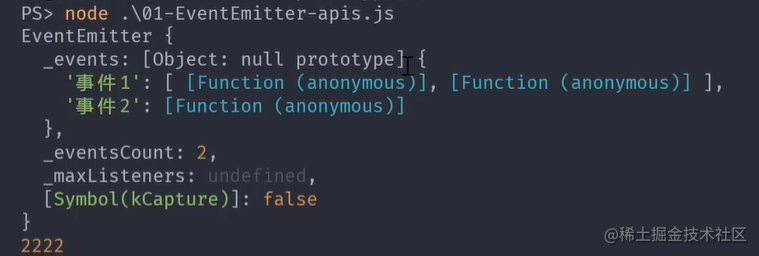
3. 发布订阅(定义对象间一对多的依赖关系)
主要解决问题:在没有 Promise 的时候,事件触发后有一连串的异步操作,这些异步又相互依赖操作结果。
工作流程:发布者发布事件,统一由调度中心,调用之前的订阅代码执行。
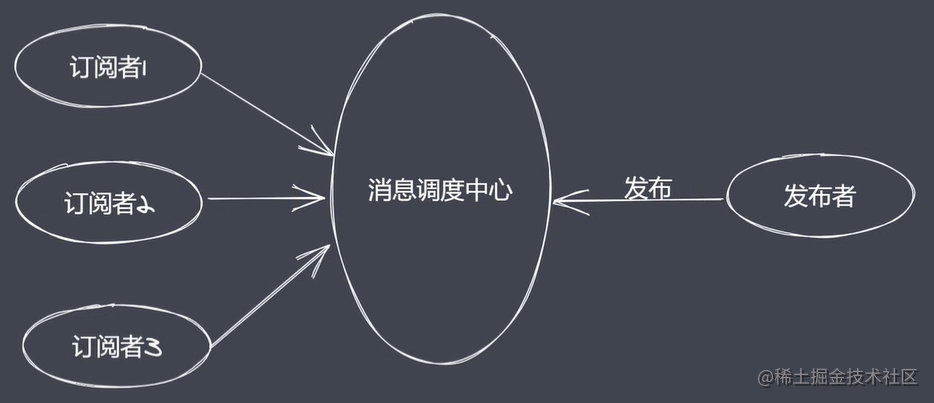
4. EventEmitter 模拟
function MyEvent() {
// 准备一个数据结构用于缓存订阅者信息
this._events = Object.create(null);
}
MyEvent.prototype.on = function (type, callback) {
// 判断当前次的事件是否已经存在,然后再决定如何做缓存
if (this._events[type]) {
this._events[type].push(callback);
} else {
this._events[type] = [callback];
}
};
MyEvent.prototype.emit = function (type, ...args) {
if (this._events && this._events[type].length) {
this._events[type].forEach((callback) => {
callback.call(this, ...args);
});
}
};
MyEvent.prototype.off = function (type, callback) {
// 判断当前 type 事件监听是否存在,如果存在则取消指定的监听
if (this._events && this._events[type]) {
this._events[type] = this._events[type].filter((item) => {
return item !== callback && item.link !== callback;
});
}
};
MyEvent.prototype.once = function (type, callback) {
let foo = function (...args) {
callback.call(this, ...args);
this.off(type, foo);
};
foo.link = callback;
this.on(type, foo);
};
let ev = new MyEvent();
let fn = function (...data) {
console.log('事件1执行了', data);
};
ev.once('事件1', fn);
// ev.off('事件1', fn)
ev.emit('事件1', '前');
function MyEvent() {
// 准备一个数据结构用于缓存订阅者信息
this._events = Object.create(null);
}
MyEvent.prototype.on = function (type, callback) {
// 判断当前次的事件是否已经存在,然后再决定如何做缓存
if (this._events[type]) {
this._events[type].push(callback);
} else {
this._events[type] = [callback];
}
};
MyEvent.prototype.emit = function (type, ...args) {
if (this._events && this._events[type].length) {
this._events[type].forEach((callback) => {
callback.call(this, ...args);
});
}
};
MyEvent.prototype.off = function (type, callback) {
// 判断当前 type 事件监听是否存在,如果存在则取消指定的监听
if (this._events && this._events[type]) {
this._events[type] = this._events[type].filter((item) => {
return item !== callback && item.link !== callback;
});
}
};
MyEvent.prototype.once = function (type, callback) {
let foo = function (...args) {
callback.call(this, ...args);
this.off(type, foo);
};
foo.link = callback;
this.on(type, foo);
};
let ev = new MyEvent();
let fn = function (...data) {
console.log('事件1执行了', data);
};
ev.once('事件1', fn);
// ev.off('事件1', fn)
ev.emit('事件1', '前');
八、事件环
1. 浏览器中的事件环
setTimeout(() => {
console.log('s1');
Promise.resolve().then(() => {
console.log('p2');
});
Promise.resolve().then(() => {
console.log('p3');
});
});
Promise.resolve().then(() => {
console.log('p1');
setTimeout(() => {
console.log('s2');
});
setTimeout(() => {
console.log('s3');
});
});
// p1 s1 p2 p3 s2 s3
setTimeout(() => {
console.log('s1');
Promise.resolve().then(() => {
console.log('p2');
});
Promise.resolve().then(() => {
console.log('p3');
});
});
Promise.resolve().then(() => {
console.log('p1');
setTimeout(() => {
console.log('s2');
});
setTimeout(() => {
console.log('s3');
});
});
// p1 s1 p2 p3 s2 s3
完整事件环执行顺序:
- 从上至下执行所有的同步代码.
- 执行过程中将遇到的宏任务与微任务添加至相应的队列.
- 同步代码执行完毕后,执行满足条件的微任务回调.
- 微任务队列执行完毕后执行所有满足需求的宏任务回调.
- 事件环操作
注意:宏任务之后就会立刻检查微任务队列
2. Nodejs 中的事件环
Nodejs 的 6 个事件队列:每一个队列中存放的都是回调函数,与浏览器一个宏任务不同。他们都有微任务队列。
- timers: 执行 setTimout 与 setInterval 回调
- pending callbacks: 执行操作系统的回调,例如 tcp udp (暂不用考虑)
- idle,prepare: 只在系统内部使用 (暂不用考虑)
- poll: 执行与 I/O 相关的回调
- check: 执行 setImmediate 中的回调
- close callbacks: 执行 close 事件回调 (暂不用考虑)
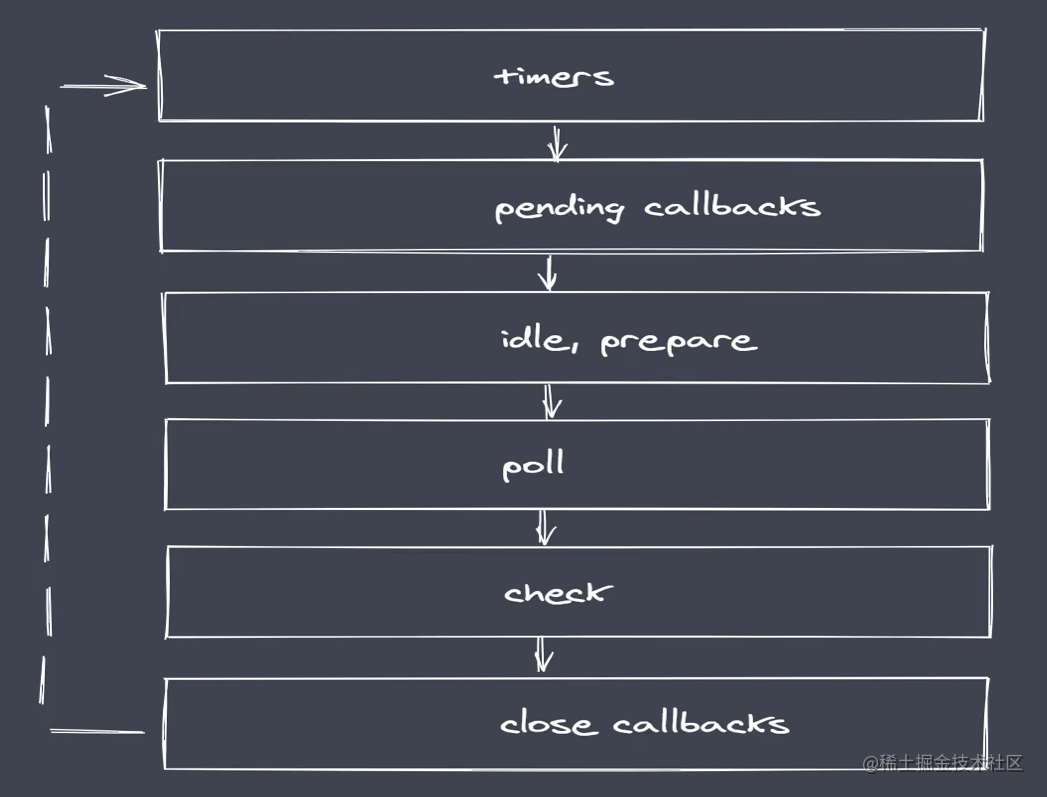
Nodejs 完整事件环的执行:
- 执行同步代码,将不同的任务添加至相应的队列
- 所有同步代码执行后会去执行满足条件微任务
- 所有微任务代码执行后会执行 timer 队列中满足的宏任务
- timer 中的所有宏任务执行完成后就会依次切换队列
注意:在完成队列切换之前会先清空微任务代码。优先级 process.nextTick() > Promise 是 Nodejs 平台的微任务。
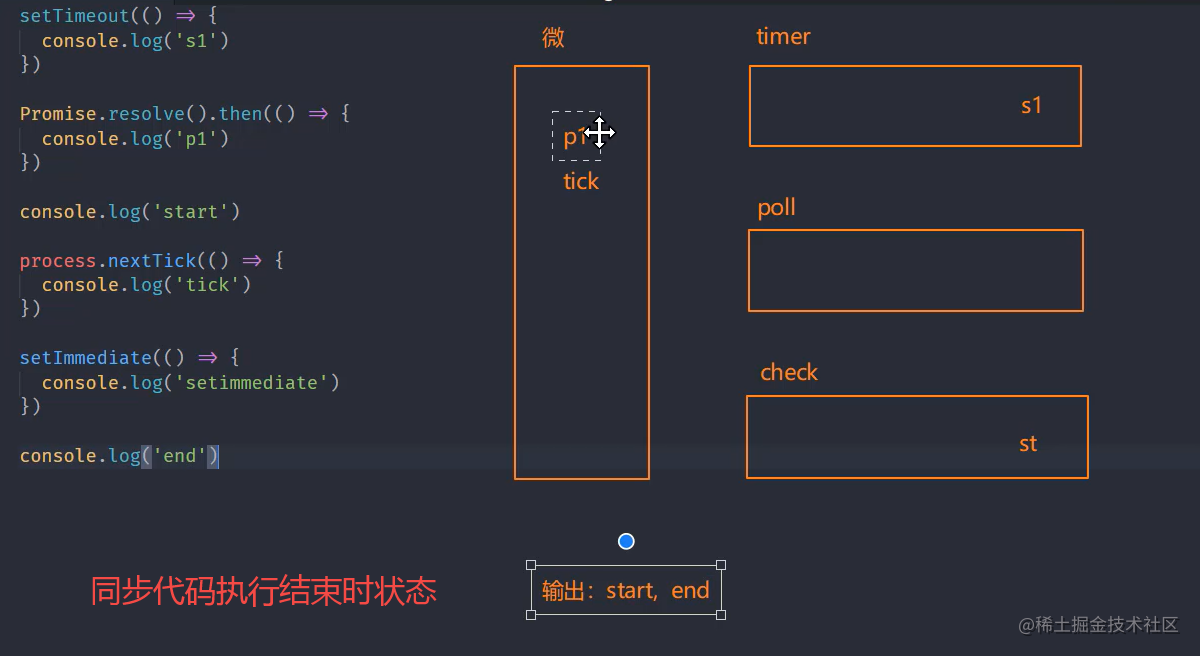
Nodejs 事件环梳理:(新版 Node 改为每执行完一个宏任务就清空微任务队列,保持和浏览器一致)
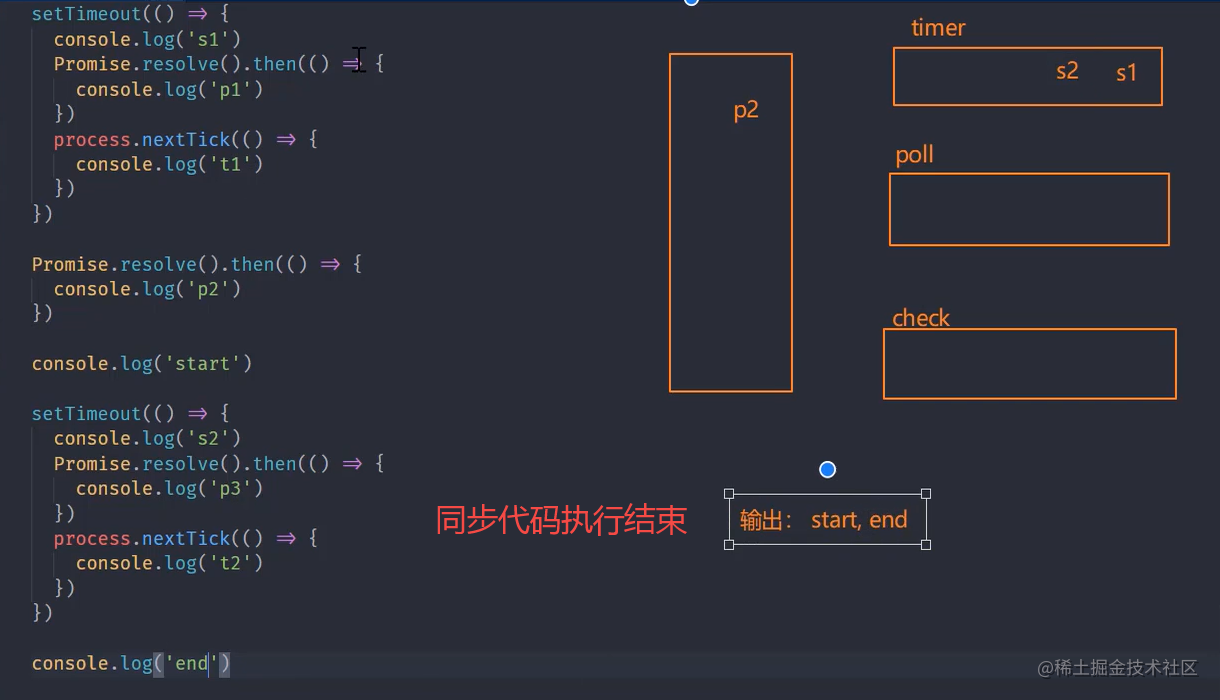
3. Nodejs 器事件环常见问题
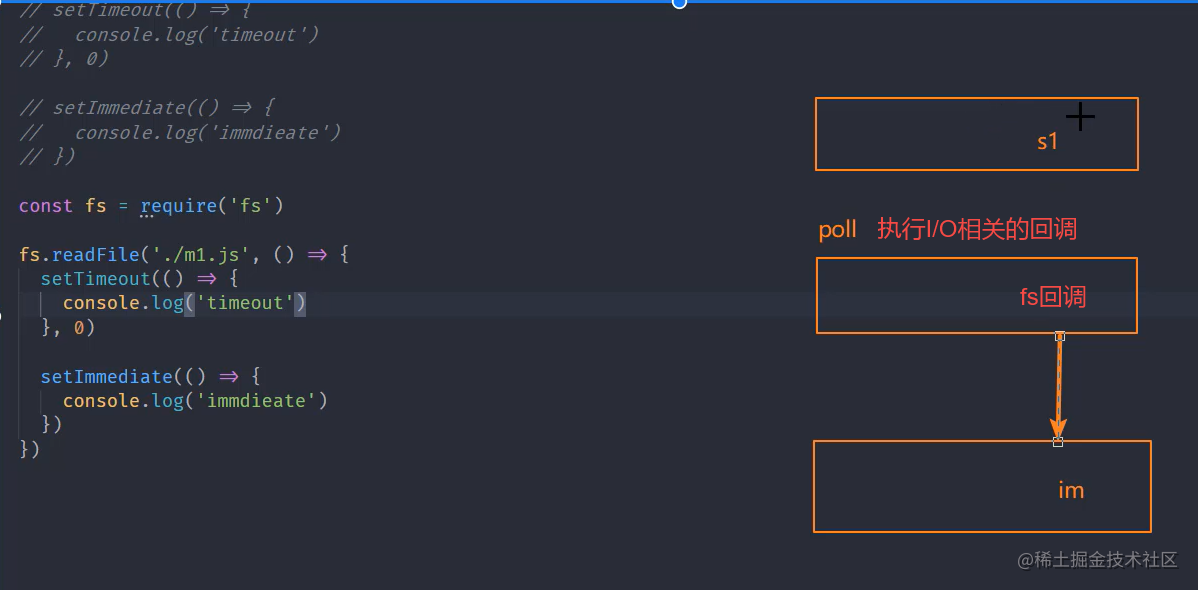
九、核心模块 Stream
文件操作系统和网络模块实现了流接口。Nodejs 中的流就是处理流式数据的抽象接口。
1. 为什么使用流来处理数据?
问题:
- 同步读取资源文件,用户需要等待数据读取完成。
- 资源文件最终一次性加载至内存,开销比较大
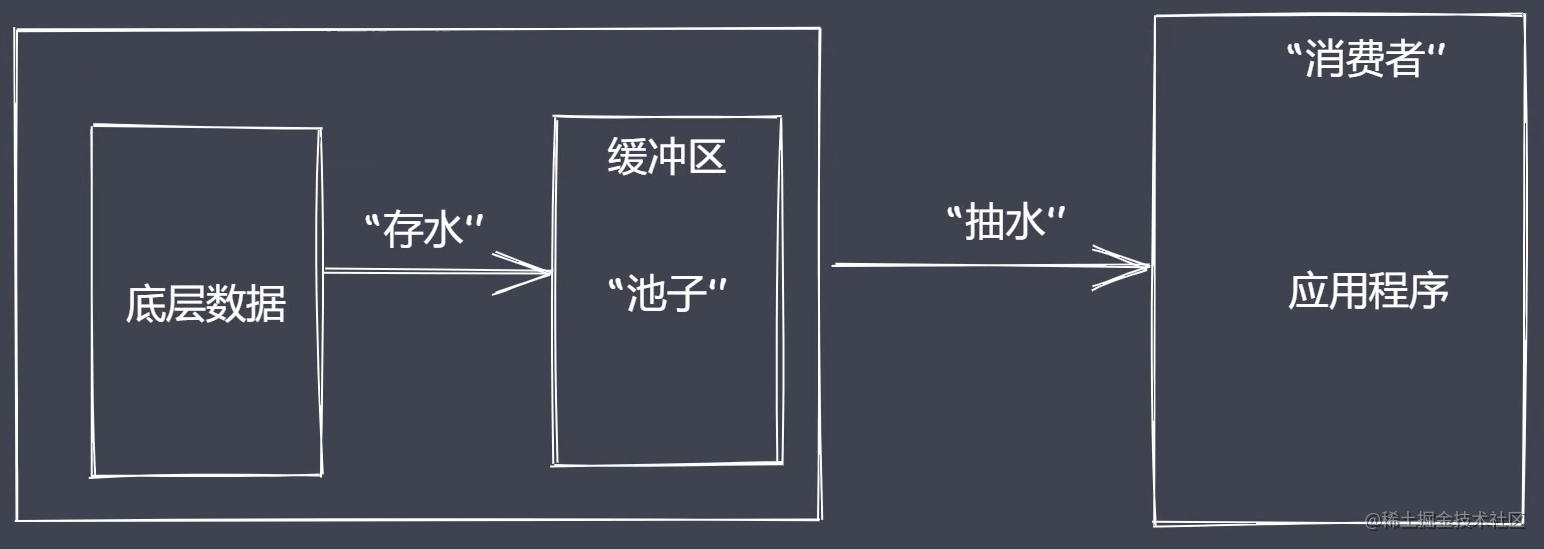
优势:
- 时间效率:流的分段处理可以同时操作多个数据 chunk
- 空间效率:同一时间无须占用大内存空间
- 使用方便:流配合管道连接,扩展程序比较简单
流的分类(以下 4 个是具体的抽象,所有的流都继承了 EventEmitter):
- Readable: 可读流,能够实现数据的读取
- Writeable: 可写流,能够事件数据的写操作
- Duplex: 双工流,即可写也可读(如 Net 模块内的 socket)
- Tranform: 转换流,可读可写,还能实现数据转换(如 Zlib 下的 createDeffort)
示例:
const fs = require('fs');
let rs = fs.createReadStream('./test.txt');
let ws = fs.createWriteStream('./test1.txt');
// 执行拷贝行为
rs.pipe(ws);
const fs = require('fs');
let rs = fs.createReadStream('./test.txt');
let ws = fs.createWriteStream('./test1.txt');
// 执行拷贝行为
rs.pipe(ws);
2. 可读流
可读流是生产供程序消费数据的流。
自定义可读流:
- 继承 stream 里 Readable
- 重写_read 方法调用 push 方法将读取的数据添加到缓冲区(一个链表结构) 自定义可读流的问题:
- 底层数据读取完成后该如何处理?给数组的最后添加一个空值
- 消费者如何获取可读流中的数据?Readable 提供了两个事件:readable 事件、data 事件,为了满足不同的数据使用场景,因此有流动模式、暂停模式。
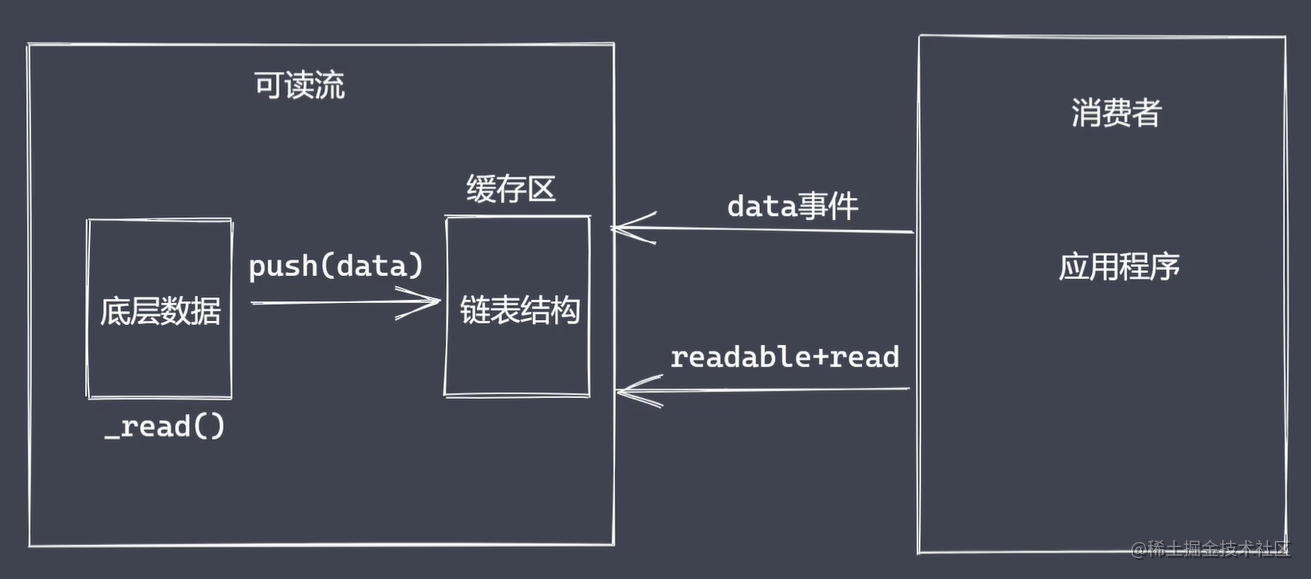
消费数据:
- reabable 事件:当缓存区准备好,也就是当流中存在可读取数据时触发。直到消费者拿到 null 之后,标识底层数据已经读取完。
- data 事件:可读流处于流动模式,当流中数据块传给消费者后触发。同样读取到 null 之后,消费行为结束。
- end 事件:数据被消费完之后触发。
const { Readable } = require('stream');
// 模拟底层数据
let source = ['lg', 'zce', 'syy'];
// 自定义类继承 Readable
class MyReadable extends Readable {
constructor(source) {
super();
this.source = source;
}
_read() {
let data = this.source.shift() || null;
this.push(data);
}
}
// 实例化
let myReadable = new MyReadable(source);
// 暂停模式
myReadable.on('readable', () => {
let data = null;
while ((data = myReadable.read(2)) != null) {
// 依次打印 lg zc es yy
console.log(data.toString());
}
});
// 流动模式 (可能都不需要往缓存中添加)
// myReadable.on('data', (chunk) => {
// //依次打印 lg zce syy
// console.log(chunk.toString())
// })
myReadable.on('end', (chunk) => {
console.log('end: 消费结束');
});
const { Readable } = require('stream');
// 模拟底层数据
let source = ['lg', 'zce', 'syy'];
// 自定义类继承 Readable
class MyReadable extends Readable {
constructor(source) {
super();
this.source = source;
}
_read() {
let data = this.source.shift() || null;
this.push(data);
}
}
// 实例化
let myReadable = new MyReadable(source);
// 暂停模式
myReadable.on('readable', () => {
let data = null;
while ((data = myReadable.read(2)) != null) {
// 依次打印 lg zc es yy
console.log(data.toString());
}
});
// 流动模式 (可能都不需要往缓存中添加)
// myReadable.on('data', (chunk) => {
// //依次打印 lg zce syy
// console.log(chunk.toString())
// })
myReadable.on('end', (chunk) => {
console.log('end: 消费结束');
});
3. 可写流
可写流是用于消费数据的流。 自定义可写流:
- 继承 stream 里 Writeable
- 重写_write 方法调用 write 方法执行写入 可写流事件:
- pipe 事件:可读流调用 pipe() 方法时触发
- unpipe 事件:可读流调用 unpipe()方法时触发
- drain 事件:中文译为抽干
const { Writable } = require('stream');
class MyWriteable extends Writable {
constructor() {
super();
}
_write(chunk, en, done) {
process.stdout.write(chunk.toString() + '<----');
process.nextTick(done);
}
}
let myWriteable = new MyWriteable();
myWriteable.write('AABBCC', 'utf-8', () => {
console.log('end');
});
const { Writable } = require('stream');
class MyWriteable extends Writable {
constructor() {
super();
}
_write(chunk, en, done) {
process.stdout.write(chunk.toString() + '<----');
process.nextTick(done);
}
}
let myWriteable = new MyWriteable();
myWriteable.write('AABBCC', 'utf-8', () => {
console.log('end');
});
4. 双工(Duplex)和转换流(Transform)
Duplex: 双工流,既能生产又能消费数据,读和写相互独立的。
let { Duplex } = require('stream')
class MyDuplex extends Duplex {
constructor(source) {
super()
this.source = source
}
_read() {
let data = this.source.shift() || null
this.push(data)
}
_write(chunk, en, next) {
process.stdout.write(chunk)
process.nextTick(next)
}
}
let source = ['a', 'b', 'c']
let myDuplex = new MyDuplex(source)
/* myDuplex.on('data', (chunk) => {
console.log(chunk.toString())
}) */
myDuplex.write('AABBXCC', () => {
console.log(1111)
})
let { Duplex } = require('stream')
class MyDuplex extends Duplex {
constructor(source) {
super()
this.source = source
}
_read() {
let data = this.source.shift() || null
this.push(data)
}
_write(chunk, en, next) {
process.stdout.write(chunk)
process.nextTick(next)
}
}
let source = ['a', 'b', 'c']
let myDuplex = new MyDuplex(source)
/* myDuplex.on('data', (chunk) => {
console.log(chunk.toString())
}) */
myDuplex.write('AABBXCC', () => {
console.log(1111)
})
Transform: 转换流,但底层将读写操作进行了联通,可以对数据相应的转换操作。
let { Transform } = require('stream');
class MyTransform extends Transform {
constructor() {
super();
}
_transform(chunk, en, cb) {
this.push(chunk.toString().toUpperCase());
cb(null);
}
}
let t = new MyTransform();
t.write('a');
t.on('data', (chunk) => {
console.log(chunk.toString());
});
let { Transform } = require('stream');
class MyTransform extends Transform {
constructor() {
super();
}
_transform(chunk, en, cb) {
this.push(chunk.toString().toUpperCase());
cb(null);
}
}
let t = new MyTransform();
t.write('a');
t.on('data', (chunk) => {
console.log(chunk.toString());
});
十、文件可读流和可写流
1. 文件可读流的创建、消费、事件、应用
const fs = require('fs');
let rs = fs.createReadStream('test.txt', {
flags: 'r',
encoding: null,
fd: null,
mode: 438,
autoClose: true,
start: 0,
// end: 3,
highWaterMark: 4,
});
/* rs.on('data', (chunk) => {
console.log(chunk.toString())
rs.pause()
setTimeout(() => {
rs.resume()
}, 1000)
}) */
/* rs.on('readable', () => {
// let data = rs.read()
// console.log(data)
let data
while((data = rs.read(1)) !== null) {
console.log(data.toString())
console.log('----------', rs._readableState.length)
}
}) */
rs.on('open', (fd) => {
console.log(fd, '文件打开了');
});
rs.on('close', () => {
console.log('文件关闭了');
});
let bufferArr = [];
rs.on('data', (chunk) => {
bufferArr.push(chunk);
});
rs.on('end', () => {
console.log(Buffer.concat(bufferArr).toString());
console.log('当数据被清空之后');
});
rs.on('error', (err) => {
console.log('出错了');
});
const fs = require('fs');
let rs = fs.createReadStream('test.txt', {
flags: 'r',
encoding: null,
fd: null,
mode: 438,
autoClose: true,
start: 0,
// end: 3,
highWaterMark: 4,
});
/* rs.on('data', (chunk) => {
console.log(chunk.toString())
rs.pause()
setTimeout(() => {
rs.resume()
}, 1000)
}) */
/* rs.on('readable', () => {
// let data = rs.read()
// console.log(data)
let data
while((data = rs.read(1)) !== null) {
console.log(data.toString())
console.log('----------', rs._readableState.length)
}
}) */
rs.on('open', (fd) => {
console.log(fd, '文件打开了');
});
rs.on('close', () => {
console.log('文件关闭了');
});
let bufferArr = [];
rs.on('data', (chunk) => {
bufferArr.push(chunk);
});
rs.on('end', () => {
console.log(Buffer.concat(bufferArr).toString());
console.log('当数据被清空之后');
});
rs.on('error', (err) => {
console.log('出错了');
});
2. 文件可写流
- 创建可写流
const fs = require('fs');
const ws = fs.createWriteStream('test.txt', {
flags: 'w',
mode: 438,
fd: null,
encoding: 'utf-8',
start: 0,
highWaterMark: 3,
});
let buf = Buffer.from('abc');
// 字符串 或者 buffer ===》 fs rs
/* ws.write(buf, () => {
console.log('ok2')
}) */
/* ws.write('AABB', () => {
console.log('ok1')
}) */
/* ws.on('open', (fd) => {
console.log('open', fd)
}) */
ws.write('2');
// close 是在数据写入操作全部完成之后再执行
/* ws.on('close', () => {
console.log('文件关闭了')
}) */
// end 执行之后就意味着数据写入操作完成
ws.end('AABB');
// error
ws.on('error', (err) => {
console.log('出错了');
});
const fs = require('fs');
const ws = fs.createWriteStream('test.txt', {
flags: 'w',
mode: 438,
fd: null,
encoding: 'utf-8',
start: 0,
highWaterMark: 3,
});
let buf = Buffer.from('abc');
// 字符串 或者 buffer ===》 fs rs
/* ws.write(buf, () => {
console.log('ok2')
}) */
/* ws.write('AABB', () => {
console.log('ok1')
}) */
/* ws.on('open', (fd) => {
console.log('open', fd)
}) */
ws.write('2');
// close 是在数据写入操作全部完成之后再执行
/* ws.on('close', () => {
console.log('文件关闭了')
}) */
// end 执行之后就意味着数据写入操作完成
ws.end('AABB');
// error
ws.on('error', (err) => {
console.log('出错了');
});
- write 执行流程
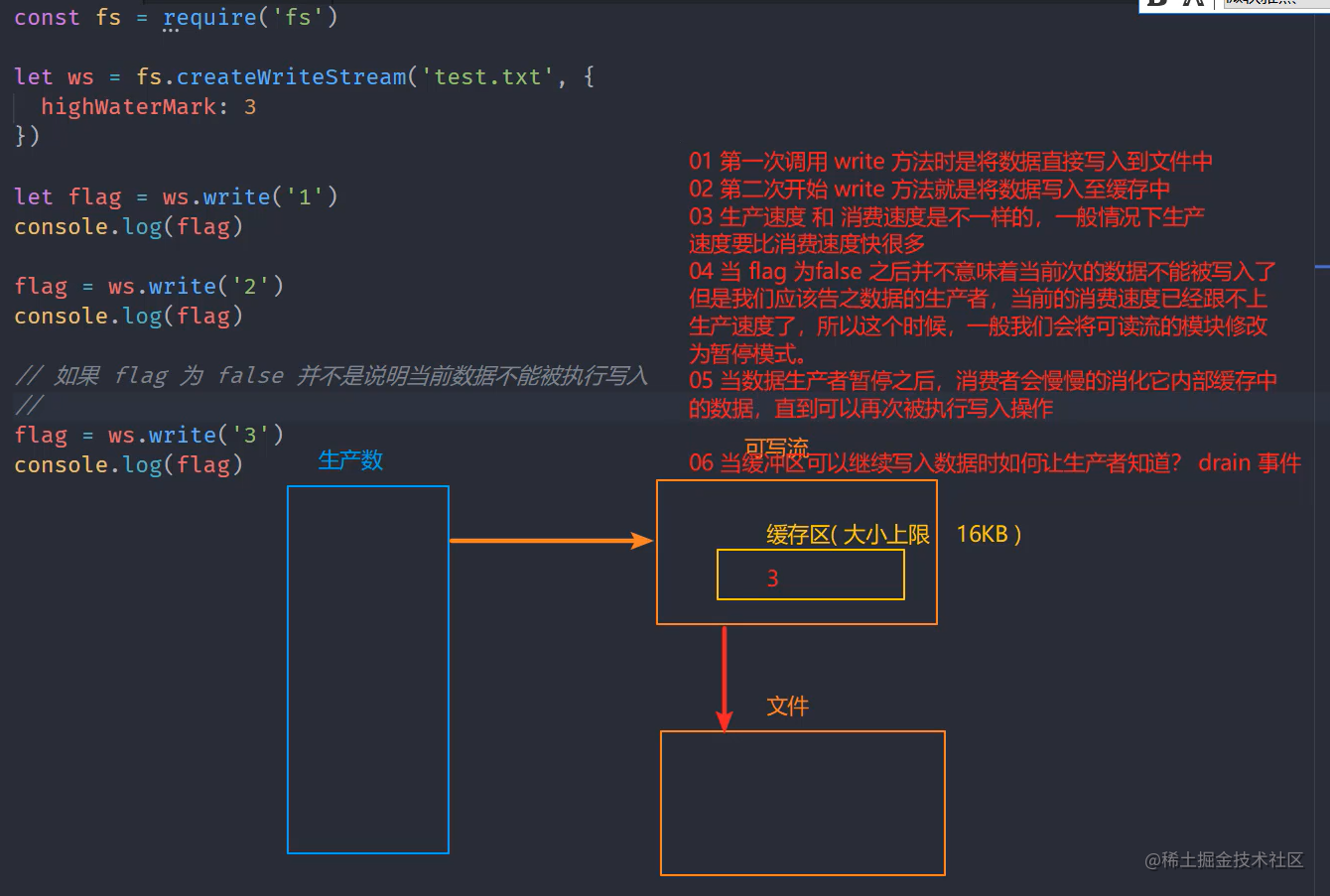
- 控制写入速度
/**
* 需求:“AABBCC” 写入指定的文件
* 01 一次性写入
* 02 分批写入
* 对比:
*/
let fs = require('fs');
let ws = fs.createWriteStream('test.txt', {
highWaterMark: 3,
});
// ws.write('AABBCC')
let source = 'AABBCC'.split('');
let num = 0;
let flag = true;
function executeWrite() {
flag = true;
while (num !== 4 && flag) {
flag = ws.write(source[num]);
num++;
}
}
executeWrite();
ws.on('drain', () => {
console.log('drain 执行了');
executeWrite();
});
/**
* 需求:“AABBCC” 写入指定的文件
* 01 一次性写入
* 02 分批写入
* 对比:
*/
let fs = require('fs');
let ws = fs.createWriteStream('test.txt', {
highWaterMark: 3,
});
// ws.write('AABBCC')
let source = 'AABBCC'.split('');
let num = 0;
let flag = true;
function executeWrite() {
flag = true;
while (num !== 4 && flag) {
flag = ws.write(source[num]);
num++;
}
}
executeWrite();
ws.on('drain', () => {
console.log('drain 执行了');
executeWrite();
});
- 背压机制:Nodejs 的 stream 已经实现了背压机制。
背压机制
这个是Reactive(反应) 的概念,当订阅者的消费能力,远低于发布者时,订阅者(也就是消费者)有通知取消或终止,发布者生产数据的机制,这种机制可以称作为'背压'。 说白了就是:当消费者消费积压的时候,反向告诉推送生产者,我不需要你生产了,你慢点,这个叫背压
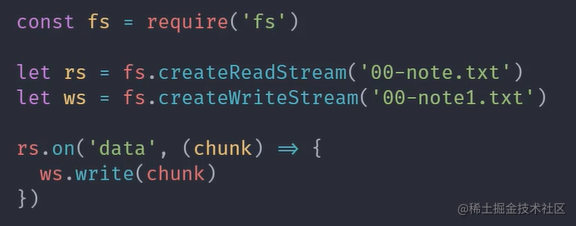
存在问题:生产者产生数据的速度远远大于消费者消费数据的速度,readable 内部维护了一个队列,将展示无法消费的数据缓存到队列中。但是队列的内存大小是有上限的(默认 16kb,文件可读流 64kb),因此读写的过程中不实现一个背压的机制,很有可能会出现内存溢出、GC 频繁调用,其他进程变慢。
数据的读操作图示:
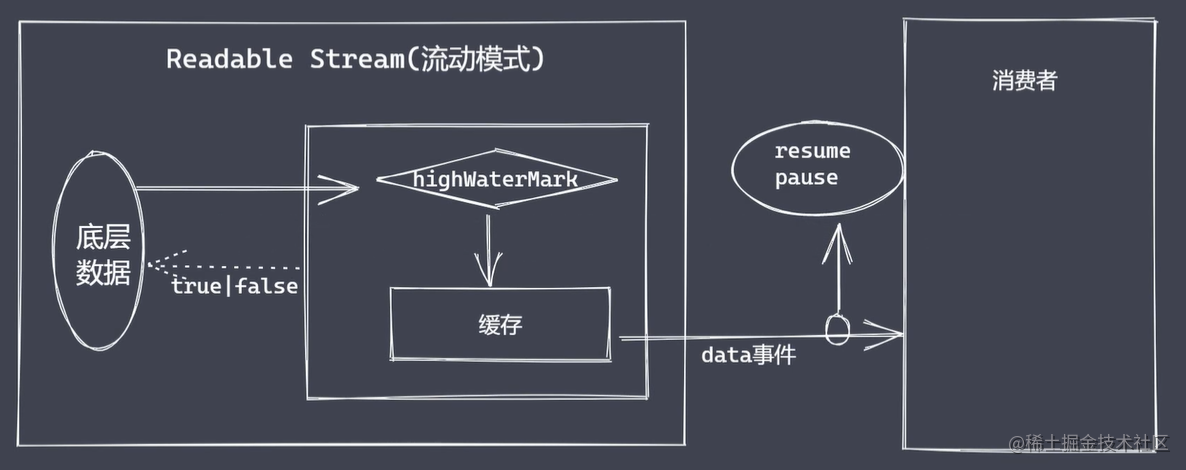
数据写操作图示:

解析 pipe 方法背压机制内部的原理:
let fs = require('fs');
let rs = fs.createReadStream('test.txt', { highWaterMark: 4 });
let ws = fs.createWriteStream('test1.txt', { highWaterMark: 1 });
let flag = true;
rs.on('data', (chunk) => {
flag = ws.write(chunk, () => {
console.log('写完了');
});
if (!flag) {
rs.pause();
}
});
ws.on('drain', () => {
rs.resume();
});
// rs.pipe(ws)
let fs = require('fs');
let rs = fs.createReadStream('test.txt', { highWaterMark: 4 });
let ws = fs.createWriteStream('test1.txt', { highWaterMark: 1 });
let flag = true;
rs.on('data', (chunk) => {
flag = ws.write(chunk, () => {
console.log('写完了');
});
if (!flag) {
rs.pause();
}
});
ws.on('drain', () => {
rs.resume();
});
// rs.pipe(ws)
3. 模拟文件可读流
const fs = require('fs');
const EventEmitter = require('events');
class MyFileReadStream extends EventEmitter {
constructor(path, options = {}) {
super();
this.path = path;
this.flags = options.flags || 'r';
this.mode = options.mode || 438;
this.autoClose = options.autoClose || true;
this.start = options.start || 0;
this.end = options.end;
this.highWaterMark = options.highWaterMark || 64 * 1024;
this.readOffset = 0;
this.open();
this.on('newListener', (type) => {
if (type === 'data') {
this.read();
}
});
}
open() {
// 原生 open 方法来打开指定位置上的文件
fs.open(this.path, this.flags, this.mode, (err, fd) => {
if (err) {
this.emit('error', err);
}
this.fd = fd;
this.emit('open', fd);
});
}
read() {
if (typeof this.fd !== 'number') {
return this.once('open', this.read);
}
let buf = Buffer.alloc(this.highWaterMark);
let howMuchToRead = this.end
? Math.min(this.end - this.readOffset + 1, this.highWaterMark)
: this.highWaterMark;
fs.read(
this.fd,
buf,
0,
howMuchToRead,
this.readOffset,
(err, readBytes) => {
if (readBytes) {
this.readOffset += readBytes;
this.emit('data', buf.slice(0, readBytes));
this.read();
} else {
this.emit('end');
this.close();
}
}
);
}
close() {
fs.close(this.fd, () => {
this.emit('close');
});
}
}
let rs = new MyFileReadStream('test.txt', {
end: 7,
highWaterMark: 3,
});
rs.on('data', (chunk) => {
console.log(chunk);
});
const fs = require('fs');
const EventEmitter = require('events');
class MyFileReadStream extends EventEmitter {
constructor(path, options = {}) {
super();
this.path = path;
this.flags = options.flags || 'r';
this.mode = options.mode || 438;
this.autoClose = options.autoClose || true;
this.start = options.start || 0;
this.end = options.end;
this.highWaterMark = options.highWaterMark || 64 * 1024;
this.readOffset = 0;
this.open();
this.on('newListener', (type) => {
if (type === 'data') {
this.read();
}
});
}
open() {
// 原生 open 方法来打开指定位置上的文件
fs.open(this.path, this.flags, this.mode, (err, fd) => {
if (err) {
this.emit('error', err);
}
this.fd = fd;
this.emit('open', fd);
});
}
read() {
if (typeof this.fd !== 'number') {
return this.once('open', this.read);
}
let buf = Buffer.alloc(this.highWaterMark);
let howMuchToRead = this.end
? Math.min(this.end - this.readOffset + 1, this.highWaterMark)
: this.highWaterMark;
fs.read(
this.fd,
buf,
0,
howMuchToRead,
this.readOffset,
(err, readBytes) => {
if (readBytes) {
this.readOffset += readBytes;
this.emit('data', buf.slice(0, readBytes));
this.read();
} else {
this.emit('end');
this.close();
}
}
);
}
close() {
fs.close(this.fd, () => {
this.emit('close');
});
}
}
let rs = new MyFileReadStream('test.txt', {
end: 7,
highWaterMark: 3,
});
rs.on('data', (chunk) => {
console.log(chunk);
});
4. 链表结构(一系列节点的集合)
数组相对链表储存队列的缺陷:
- 在多个语言下,数组存放数据的长度具有上限。
- 数组在插入和删除元素时,都会移动其他元素的位置。
- 在 JS 中数组被实现成了一个对象,在使用效率上会低一些。
链表分类:
- 双向链表
- 单向链表
- 循环链表
单向链表(默认 head 指向 null):
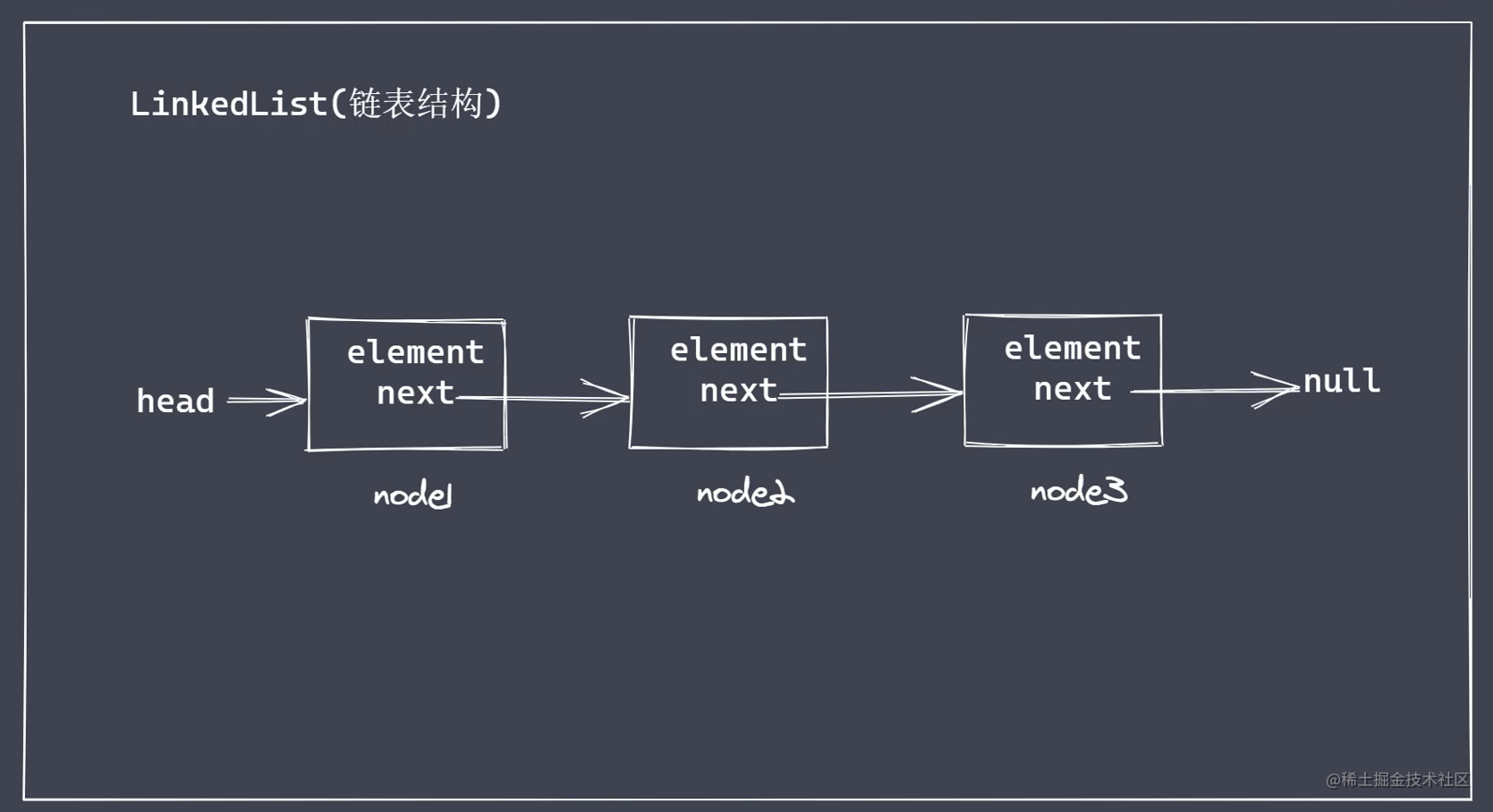
双向链表就是在 element 节点上增加一个 prev 属性。循环链表是将首位链接起来。
单向链表实现:
/*
01 node + head + null
02 head --->null
03 size
04 next element
05 增加 删除 修改 查询 清空
*/
class Node {
constructor(element, next) {
this.element = element;
this.next = next;
}
}
class LinkedList {
constructor(head, size) {
this.head = null;
this.size = 0;
}
_getNode(index) {
if (index < 0 || index >= this.size) {
throw new Error('越界了');
}
let currentNode = this.head;
for (let i = 0; i < index; i++) {
currentNode = currentNode.next;
}
return currentNode;
}
add(index, element) {
if (arguments.length == 1) {
element = index;
index = this.size;
}
if (index < 0 || index > this.size) {
throw new Error('cross the border');
}
if (index == 0) {
let head = this.head; // 保存原有 head 的指向
this.head = new Node(element, head);
} else {
let prevNode = this._getNode(index - 1);
prevNode.next = new Node(element, prevNode.next);
}
this.size++;
}
remove(index) {
if (index == 0) {
let head = this.head;
this.head = head.next;
} else {
let prevNode = this._getNode(index - 1);
prevNode.next = prevNode.next.next;
}
this.size--;
}
set(index, element) {
let node = this._getNode(index);
node.element = element;
}
get(index) {
return this._getNode(index);
}
clear() {
this.head = null;
this.size = 0;
}
}
const l1 = new LinkedList();
l1.add('node1');
l1.add('node2');
l1.add(1, 'node3');
// l1.remove(1)
l1.set(1, 'node3-3');
// let a = l1.get(0)
l1.clear();
console.log(l1);
/*
01 node + head + null
02 head --->null
03 size
04 next element
05 增加 删除 修改 查询 清空
*/
class Node {
constructor(element, next) {
this.element = element;
this.next = next;
}
}
class LinkedList {
constructor(head, size) {
this.head = null;
this.size = 0;
}
_getNode(index) {
if (index < 0 || index >= this.size) {
throw new Error('越界了');
}
let currentNode = this.head;
for (let i = 0; i < index; i++) {
currentNode = currentNode.next;
}
return currentNode;
}
add(index, element) {
if (arguments.length == 1) {
element = index;
index = this.size;
}
if (index < 0 || index > this.size) {
throw new Error('cross the border');
}
if (index == 0) {
let head = this.head; // 保存原有 head 的指向
this.head = new Node(element, head);
} else {
let prevNode = this._getNode(index - 1);
prevNode.next = new Node(element, prevNode.next);
}
this.size++;
}
remove(index) {
if (index == 0) {
let head = this.head;
this.head = head.next;
} else {
let prevNode = this._getNode(index - 1);
prevNode.next = prevNode.next.next;
}
this.size--;
}
set(index, element) {
let node = this._getNode(index);
node.element = element;
}
get(index) {
return this._getNode(index);
}
clear() {
this.head = null;
this.size = 0;
}
}
const l1 = new LinkedList();
l1.add('node1');
l1.add('node2');
l1.add(1, 'node3');
// l1.remove(1)
l1.set(1, 'node3-3');
// let a = l1.get(0)
l1.clear();
console.log(l1);
单向链表实现队列(先进先出-可写流的 readable):
// 接上代码
class Queue {
constructor() {
this.linkedList = new LinkedList();
}
enQueue(data) {
this.linkedList.add(data);
}
deQueue() {
return this.linkedList.remove(0);
}
}
const q = new Queue();
q.enQueue('node1');
q.enQueue('node2');
let a = q.deQueue();
a = q.deQueue();
a = q.deQueue();
console.log(a);
// 接上代码
class Queue {
constructor() {
this.linkedList = new LinkedList();
}
enQueue(data) {
this.linkedList.add(data);
}
deQueue() {
return this.linkedList.remove(0);
}
}
const q = new Queue();
q.enQueue('node1');
q.enQueue('node2');
let a = q.deQueue();
a = q.deQueue();
a = q.deQueue();
console.log(a);
5. 模拟文件可写流
const fs = require('fs')
const EventsEmitter = require('events')
const Queue = require('../09Linklist/4-linked-queue')
class MyWriteStream extends EventsEmitter{
constructor(path, options={}) {
super()
this.path = path
this.flags = options.flags || 'w'
this.mode = options.mode || 438
this.autoClose = options.autoClose || true
this.start = options.start || 0
this.encoding = options.encoding || 'utf8'
this.highWaterMark = options.highWaterMark || 16*1024
this.open()
this.writeoffset = this.start
this.writing = false
this.writeLen = 0
this.needDrain = false
this.cache = new Queue()
}
open() {
// 原生 fs.open
fs.open(this.path, this.flags, (err, fd) => {
if (err) {
this.emit('error', err)
}
// 正常打开文件
this.fd = fd
this.emit('open', fd)
})
}
write(chunk, encoding, cb) {
chunk = Buffer.isBuffer(chunk) ? chunk : Buffer.from(chunk)
this.writeLen += chunk.length
let flag = this.writeLen < this.highWaterMark
this.needDrain = !flag
if (this.writing) {
// 当前正在执行写入,所以内容应该排队
this.cache.enQueue({chunk, encoding, cb})
} else {
this.writing = true
// 当前不是正在写入那么就执行写入
this._write(chunk, encoding, () => {
cb()
// 清空排队的内容
this._clearBuffer()
})
}
return flag
}
_write(chunk, encoding, cb) {
if (typeof this.fd !== 'number') {
return this.once('open', ()=>{return this._write(chunk, encoding, cb)})
}
fs.write(this.fd, chunk, this.start, chunk.length, this.writeoffset, (err, written) => {
this.writeoffset += written
this.writeLen -= written
cb && cb()
})
}
_clearBuffer() {
let data = this.cache.deQueue()
if (data) {
this._write(data.element.chunk, data.element.encoding, ()=>{
data.element.cb && data.element.cb()
this._clearBuffer()
})
} else {
if (this.needDrain) {
this.needDrain = false
this.emit('drain')
}
}
}
}
const ws = new MyWriteStream('./f9.txt', {})
ws.on('open', (fd) => {
console.log('open---->', fd)
})
let flag = ws.write('1', 'utf8', () => {
console.log('ok1')
})
flag = ws.write('10', 'utf8', () => {
console.log('ok1')
})
flag = ws.write('xxx', 'utf8', () => {
console.log('ok3')
})
ws.on('drain', () => {
console.log('drain')
})
const fs = require('fs')
const EventsEmitter = require('events')
const Queue = require('../09Linklist/4-linked-queue')
class MyWriteStream extends EventsEmitter{
constructor(path, options={}) {
super()
this.path = path
this.flags = options.flags || 'w'
this.mode = options.mode || 438
this.autoClose = options.autoClose || true
this.start = options.start || 0
this.encoding = options.encoding || 'utf8'
this.highWaterMark = options.highWaterMark || 16*1024
this.open()
this.writeoffset = this.start
this.writing = false
this.writeLen = 0
this.needDrain = false
this.cache = new Queue()
}
open() {
// 原生 fs.open
fs.open(this.path, this.flags, (err, fd) => {
if (err) {
this.emit('error', err)
}
// 正常打开文件
this.fd = fd
this.emit('open', fd)
})
}
write(chunk, encoding, cb) {
chunk = Buffer.isBuffer(chunk) ? chunk : Buffer.from(chunk)
this.writeLen += chunk.length
let flag = this.writeLen < this.highWaterMark
this.needDrain = !flag
if (this.writing) {
// 当前正在执行写入,所以内容应该排队
this.cache.enQueue({chunk, encoding, cb})
} else {
this.writing = true
// 当前不是正在写入那么就执行写入
this._write(chunk, encoding, () => {
cb()
// 清空排队的内容
this._clearBuffer()
})
}
return flag
}
_write(chunk, encoding, cb) {
if (typeof this.fd !== 'number') {
return this.once('open', ()=>{return this._write(chunk, encoding, cb)})
}
fs.write(this.fd, chunk, this.start, chunk.length, this.writeoffset, (err, written) => {
this.writeoffset += written
this.writeLen -= written
cb && cb()
})
}
_clearBuffer() {
let data = this.cache.deQueue()
if (data) {
this._write(data.element.chunk, data.element.encoding, ()=>{
data.element.cb && data.element.cb()
this._clearBuffer()
})
} else {
if (this.needDrain) {
this.needDrain = false
this.emit('drain')
}
}
}
}
const ws = new MyWriteStream('./f9.txt', {})
ws.on('open', (fd) => {
console.log('open---->', fd)
})
let flag = ws.write('1', 'utf8', () => {
console.log('ok1')
})
flag = ws.write('10', 'utf8', () => {
console.log('ok1')
})
flag = ws.write('xxx', 'utf8', () => {
console.log('ok3')
})
ws.on('drain', () => {
console.log('drain')
})
 Attraction11
Attraction11